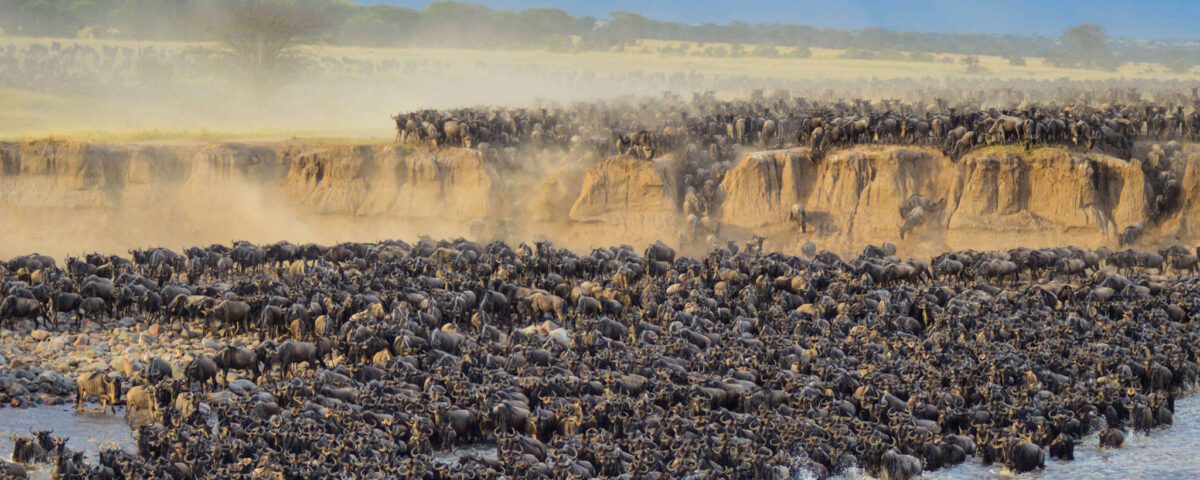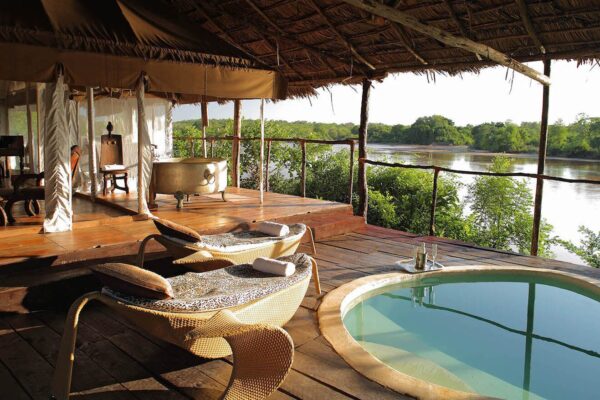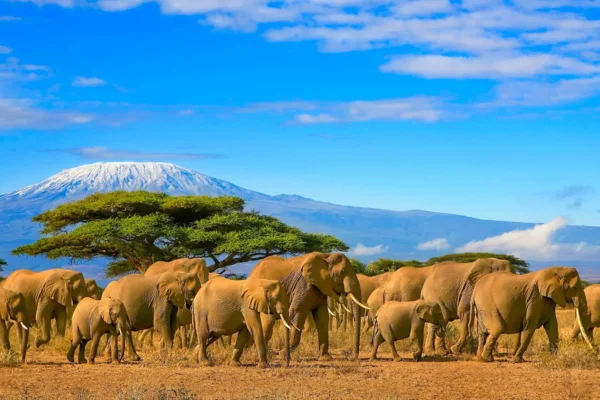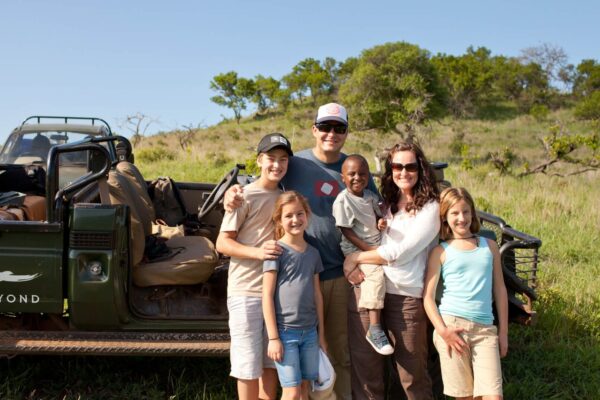
Big Five Safari in Tanzania
April 16, 2025
How to Plan a Family Safari in Tanzania
April 17, 2025Exploring the Great Wildebeest Migration: When, Where, and How
Introduction: Witness the Greatest Wildlife Show on Earth
Few natural phenomena can rival the in scale, intensity, and visual drama. Every year, more than 1.5 million wildebeest, accompanied by zebras and gazelles, undertake a treacherous journey across the Serengeti-Mara ecosystem in search of fresh grazing grounds. This circular movement—spanning Tanzania and Kenya—is not only one of the largest land mammal migrations on Earth, but also a spectacle that has earned its place among the Seven Natural Wonders of Africa.
For wildlife enthusiasts, photographers, and adventurers, experiencing this event firsthand is a dream come true. But the migration is a year-round phenomenon that changes location depending on the season. To truly make the most of it, knowing when to go, where to be, and how to explore is essential.
In this comprehensive guide, Traford Safaris Ltd takes you through the seasonal highlights of the migration, the best parks and regions to visit, and how to plan your safari for the ultimate encounter with this breathtaking natural event.
January to March: Calving Season in Southern Serengeti
Best Region: Ndutu Plains (Southern Serengeti and Northern Ngorongoro)
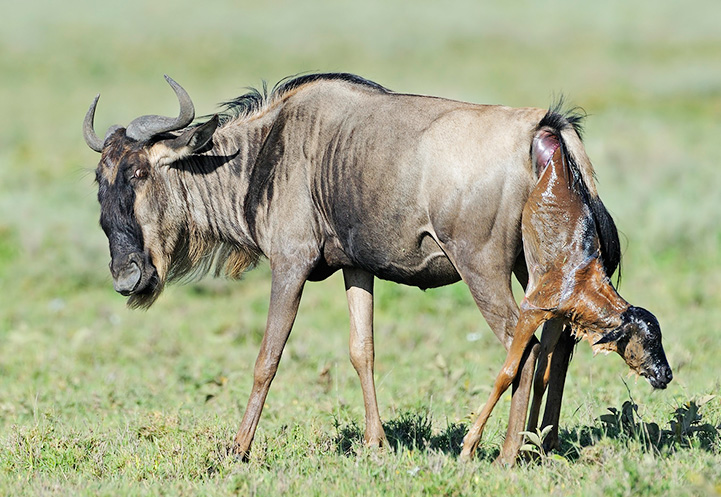
From late January through March, the vast Ndutu plains transform into a lush, green paradise. This is the time when the wildebeest give birth, and approximately 8,000 calves are born each day at the peak of the season. The calving season is truly a sight to behold—newborns taking their first steps, herds stretching to the horizon, and predators lurking in the shadows.
This period is particularly popular among photographers and filmmakers because of the stunning contrast between life and death. Predators like lions, cheetahs, hyenas, and jackals capitalize on the abundance of vulnerable young, making for action-packed game drives.
Accessibility to the Ndutu region is relatively easy, and the flat, open plains offer fantastic visibility, perfect for tracking animal behavior and capturing unforgettable moments.
Why Visit Now:
-
See thousands of wildebeest calves born
-
Intense predator-prey interactions
-
Lush landscapes and stunning photo ops
April to May: The Green Season and Northward Movement
Best Region: Central Serengeti
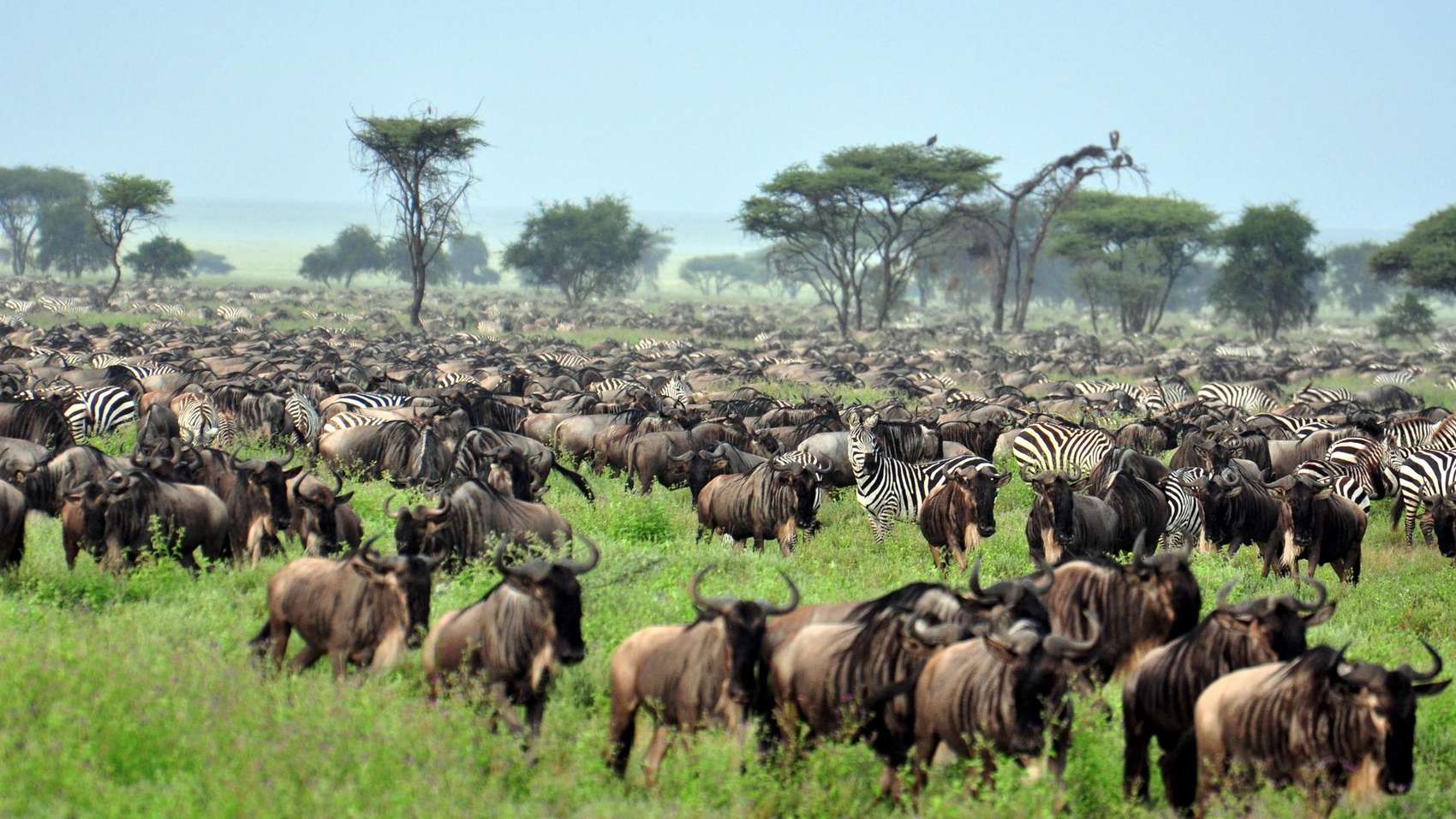
As the long rains begin in April, the herds begin moving northward from Ndutu through the Seronera region of Central Serengeti. While this is considered the “low season” due to the rain, it’s actually a hidden gem for travelers who want to avoid the crowds and enjoy the wilderness at a slower, more peaceful pace.
The rains bring an explosion of green—rolling hills, tall grass, and blooming flowers. The herds are scattered and mobile, feeding on the rich grasses while slowly making their way toward the Western Corridor.
This is an excellent time for spotting large predators, especially lions and leopards, as they often remain in this region even as the wildebeest pass through. Birdlife is also especially rich during this period, attracting nature lovers and ornithologists.
Why Visit Now:
-
Fewer tourists and lower lodge rates
-
Vibrant greenery and birdwatching
-
Great big cat sightings
June to July: Grumeti River Crossings in the Western Corridor
Best Region: Western Serengeti (Grumeti Reserves)

In June, the wildebeest arrive at the Grumeti River, the first major water obstacle on their journey. The river is home to massive Nile crocodiles, and the crossing events here—while not as dramatic as those in the north—are still filled with tension and life-or-death decisions.
The Western Corridor is less visited than other parts of Serengeti, making it ideal for travelers seeking a more exclusive, uncrowded safari. Lodges in this area offer spectacular access to the river and migration routes, with sweeping views over the plains and forested ravines.
This is the start of the dry season, meaning wildlife viewing is easier as animals gather near water sources and the vegetation begins to thin out. With excellent chances of predator action and thrilling crossings, June and July offer prime safari conditions.
Why Visit Now:
-
Witness Grumeti River crossings
-
Excellent weather and fewer bugs
-
High predator density and photographic opportunities
August to October: Mara River Crossings in Northern Serengeti

Best Region: Kogatende & Lamai Wedge (Northern Serengeti)
This is the epic climax of the Great Migration. Between August and October, the herds reach the Mara River, which separates Tanzania from Kenya’s Maasai Mara. The crossings here are the most dramatic of the entire migration—thousands of wildebeest hurling themselves into crocodile-infested waters, while predators wait on both banks.
Staying in Kogatende or Lamai, travelers can witness multiple river crossings from both land and air (via hot-air balloon safaris). The crossings are unpredictable, often occurring multiple times a day, and the sheer noise, energy, and chaos of the event are unforgettable.
The landscape here is incredibly scenic, with a mix of rocky outcrops, forested riverbanks, and golden savannahs. The area is also home to resident wildlife, so even when the herds move on, the game viewing remains exceptional.
Why Visit Now:
-
Most dramatic and iconic migration moments
-
High concentration of wildlife and predators
-
Best time for river-crossing photography
November to December: Return to the Southern Plains
Best Region: Eastern and Southern Serengeti
As the short rains begin in November, the herds begin their journey southward, completing the circular migration. By December, most wildebeest have returned to the Ndutu and Southern Serengeti plains, where fresh grass awaits.
This is the start of the cycle once again, as the wildebeest prepare for another calving season in January. While the action may be less dramatic than the river crossings, this period is still a great time for safari-goers who want to experience plentiful game viewing without peak-season crowds.
The light rains transform the landscape into a beautiful, emerald sea. You’ll witness large numbers of wildebeest, zebra, and gazelle, often moving in vast columns across the land. Predator sightings are still common, especially cheetahs who love the open plains.
Why Visit Now:
-
Beautiful green landscapes
-
Large herds and predator sightings
-
Good rates and less tourist traffic
How to Experience the Migration with Traford Safaris Ltd
Planning a trip around the migration requires expert timing, local knowledge, and flexibility. At Traford Safaris Ltd, we specialize in tailor-made migration safaris that ensure you’re in the right place at the right time.
Here’s how we make your dream safari seamless:
✅ Custom Itineraries
We monitor herd movements and design dynamic itineraries based on real-time migration updates, ensuring you won’t miss a thing.
✅ Exclusive Camps & Lodges
We partner with mobile tented camps that follow the herds, as well as permanent luxury lodges in strategic locations like Kogatende, Ndutu, and Grumeti.
✅ Game Drives & Balloon Safaris
Enjoy private game drives, fly-in options, and hot air balloon safaris for unmatched aerial views of the migration.
✅ Expert Safari Guides
Our guides are trained naturalists and trackers who know the land and animal behavior intimately—your best chance at thrilling sightings.
Whether you’re a solo traveler, couple, family, or photography group, we offer custom solutions for every style and budget.
Conclusion: The Migration Awaits
The Great Wildebeest Migration is more than just a wildlife event—it’s a story of survival, instinct, and wonder. Every stage of the journey offers something unique, whether it’s the emotional moment of a newborn calf’s first breath or the adrenaline rush of a river crossing.
With Traford Safaris Ltd, you’re not just watching nature—you’re living it. Let us help you plan your ultimate migration experience with curated routes, expert guides, and accommodations as adventurous or luxurious as you desire.
captainform id=”1349083″


